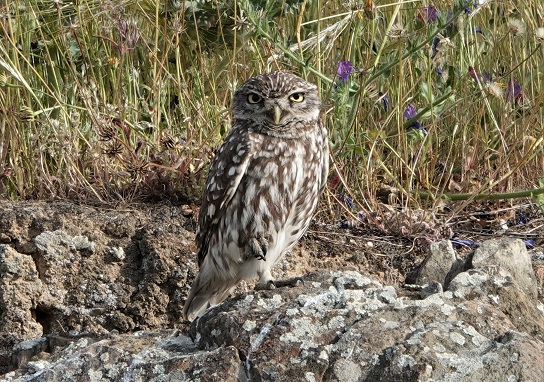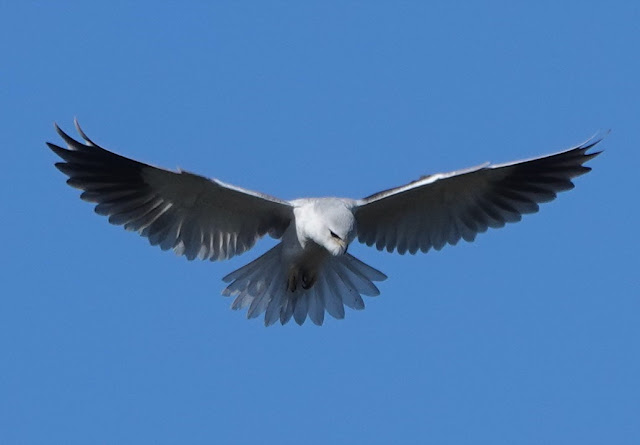Stand-by
 |
| Booted Eagle in September (John Hawkins) |
Summer clings on, despite the delicious freshness at dawn. The countryside is poised on stand-by until the first rains of autumn. The sound of August's piping Bee-eaters have long gone and replaced by the incongruous cheeping of Booted Eagles. Slowly circling against the porcelain sky, this aggressive small eagle utters a premigratory chitting call, recalling a slowed-down version of the cheeps of a day-old poultry chick. I hear this call in the spring as well, as pairs dance over newly established territories. Now it seems like a lament, to the vestige of their sojourn here in Extremadura.
There is barely no other movement. Clusters of House Martins on the wires disperse into a void during the day, and Red-rumped Swallows, now in family groups, descend in wide glides to nest sites to roost at dusk. But during the day, a heavy emptiness hangs over the olive groves and fields. Only the indefatigable Heliotrope is in flower, somehow finding sustenance in the dust. But sit and observe. There is a silent migration underway. A flitter betrays a Pied Flycatcher, appearing from the base of low canopy to seize an insect and withdrawing again to perch, almost invisibly, in the shadows. When one bird encounters another, there will be the short, whip-crack like calls of contact breaking the brooding silence. I can see more Pied Flycatchers in half an hour at this time of the year, than in the whole of spring: testament to a loop migration which sends millions through the Iberian Peninsular as they move south, whilst their northward return takes them much further to the east. Each day small birds are trickling through, pausing, feeding and resting: flyatchers, redstarts, Whinchats, Willow Warblers, Garden Warblers and Whitethroats. They appear briefly from cover, quietly waiting for garrulous Azure-winged Magpies to finish bathing and drinking at the few remaining places where water can be found.
The story is different in places where there is a lot of water. The rice harvest is now underway and yesterday I sat in my car and watched as just a few feet away from me bundles of Cattle Egrets, Little Egrets and a Squacco Heron, joined by Lesser Black-backed and Black-headed Gulls, clamboured and leap-frogged over each other as a tractor mashed the stubble into an oozy, food-rich quagmire. Far more dainty were the Yellow Wagtails (I counted over eighty in a field barely the size of two tennis courts) busy catching smaller prey. Their movements were jerky yet purposeful, taking long darting strides culminating with a split-second lunge (sometimes aided by a flutter of the wings) to pick-up an insect with their tweezer-like bills. Across this constantly moving flock, there was a staggering variation of colours, from rather grey juvenile birds to males in rich satin hues of yellows, olive-greens, whites and blues. They were colour-coded as per their origin: Iberian birds with bluish heads, yellow underparts and white throats, Central European birds with yellow throats and darker blue heads and at least two British birds with a glorious strong-lemon, suffused against a more yellow-toned green on the backs, how appropriate their subspecific trinomial: Motacilla flava flavissima!
 |
| Yellow Wagtail (M.f.favissima) Martin Kelsey |
I stopped to take a look at a small gravel-based water tank, thronging with Mallard and Teal, still in postnuptial eclipse plumage. Some migrant Pintail up-ended and swimming close to them were four juvenile Great Flamingos, part of an usually large influx into Extremadura this year. A party of coot were reaching up to pick off seeds from some inundated grasses. I gave them a casual check with my telescope, as a final gesture before heading back to car. One caught my attention with its rear-end pushed up more markedly than usual. As it turned, its bluish bill contrasted with a smooth-sided white frontal shield with a distinctive square-top. I realised that I had just found a Red-knobbed Coot, a rarity in Extremadura from the deep south of Spain, perhaps dispersing outwards from the drought-ridden marismas. It was the first I had seen in the region for over a year.
 |
| Red-knobbed Coot (rather distant) Martin Kelsey |



Comments